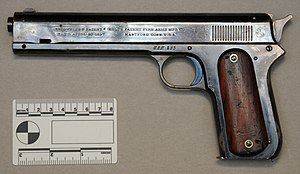
The Colt M1911 is a single-action, recoil-operated, semi-automatic pistol chambered for the .45 ACP cartridge. The pistol's formal U.S. military designation as of 1940 was Automatic Pistol, Caliber .45, M1911 for the original model adopted in March 1911, and Automatic Pistol, Caliber .45, M1911A1 for the improved M1911A1 model which entered service in 1926. The designation changed to Pistol, Caliber .45, Automatic, M1911A1 in the Vietnam War era.

A semi-automatic pistol is a handgun that automatically ejects and loads cartridges in its chamber after every shot fired. Only one round of ammunition is fired each time the trigger is pulled, as the pistol's fire control group disconnects the trigger mechanism from the firing pin/striker until the trigger has been released and reset.

The Colt Single Action Army is a single-action revolver handgun. It was designed for the U.S. government service revolver trials of 1872 by Colt's Patent Firearms Manufacturing Company and was adopted as the standard-issued pistol of the U.S. Army from 1873 until 1892.

The .45 ACP, also known as .45 Auto, .45 Automatic, or 11.43×23mm is a rimless straight-walled handgun cartridge designed by John Moses Browning in 1904, for use in his prototype Colt semi-automatic pistol. After successful military trials, it was adopted as the standard chambering for Colt's M1911 pistol. The round was developed due to a lack of stopping power experienced in the Moro Rebellion in places like Sulu. The issued ammunition, .38 Long Colt, had proved inadequate, motivating the search for a better cartridge. This experience and the Thompson–LaGarde Tests of 1904 led the Army and the Cavalry to decide that a minimum of .45 caliber was required in a new handgun cartridge.

The .380 ACP, is a rimless, straight-walled pistol cartridge developed by firearms designer John Moses Browning. The cartridge headspaces on the mouth of the case. It was introduced in 1908 by Colt, for use in its new Colt Model 1908 pocket hammerless semi-automatic, and has been a popular self-defense cartridge ever since, seeing wide use in numerous handguns. Other names for .380 ACP include .380 Auto, 9×17mm, 9mm Browning, 9mm Corto, 9mm Kurz, 9mm Short, and 9mm Browning Court. It should not be confused with .38 ACP. The .380 ACP does not strictly conform to cartridge naming conventions, named after the diameter of the bullet, as the actual bullet diameter of the .380 ACP is .355 inches.
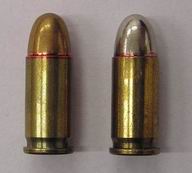
.32 ACP is a centerfire pistol cartridge. It is a semi-rimmed, straight-walled cartridge developed by firearms designer John Browning, initially for use in the FN M1900 semi-automatic pistol. It was introduced in 1899 by Fabrique Nationale, and is also known as the 7.65 mm Browning Short.

The .38 Super, also known as .38 Super Auto, .38 Super Automatic, .38 Super Automatic +P , .38 Super +P , or 9×23mmSR, is a pistol cartridge that fires a 0.356-inch-diameter (9.04 mm) bullet. It was introduced in the late 1920s as a higher pressure loading of the .38 ACP, also known as .38 Auto. The older .38 ACP cartridge propels a 130-grain (8.4 g) bullet at 1,050 ft/s (320.0 m/s), whereas the .38 Super pushes the same bullet at 1,280 ft/s (390.1 m/s). The .38 Super has gained distinction as the caliber of choice for many top practical shooting competitors; it remains one of the dominant calibers in IPSC competition.

The .45 Colt (11.43×33mmR), is a rimmed, straight-walled, handgun cartridge dating to 1872. It was originally a black-powder revolver round developed for the Colt Single Action Army revolver. This cartridge was adopted by the U.S. Army in 1873 and served as an official US military handgun cartridge for 19 years, before being replaced by the .38 Long Colt in 1892.
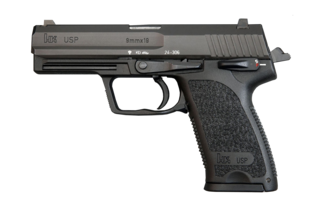
The USP is a semi-automatic pistol developed in Germany by Heckler & Koch GmbH (H&K) as a replacement for the P7 series of handguns.

In American English, a pocket pistol is any small, pocket-sized semi-automatic pistol, and is suitable for concealed carry in a pocket or a similar small space.

The Colt Model 1903 Pocket Hammerless is a .32 ACP caliber, self-loading, semi-automatic pistol designed by John Browning and built by Colt Patent Firearms Manufacturing Company of Hartford, Connecticut. The Colt Model 1908 Pocket Hammerless is a variant introduced five years later in .380 ACP caliber. Despite the title "hammerless", the Model 1903 does have a hammer. The hammer is covered and hidden from view under the rear of the slide, this allows the pistol to be carried in and withdrawn from a pocket quickly and smoothly without snagging.
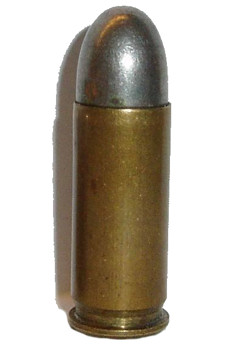
The .38 ACP, also known as the .38 Auto, .38 Automatic, or 9x23mmSR, is a semi-rimmed pistol cartridge that was introduced at the turn of the 20th century for the John Browning-designed Colt M1900. It was first used in Colt's Model 1897 prototype, which he did not produce. The metric designation for the round is 9×23mm SR (semi-rimmed), which is not to be confused with other 9×23mm cartridges.

The Grizzly Win Mag pistols were conceived, invented, designed, engineered and developed in the 1980s by the sole inventor, Perry Arnett, who licensed his patent for an interchangeable caliber semi-automatic pistol to L.A.R. Manufacturing Inc. Perry Arnett's designs were initially flawed and were improved upon by Heinz Augat. The L.A.R. Grizzly was the most powerful semi-automatic pistol ever commercially produced after the Desert Eagle.
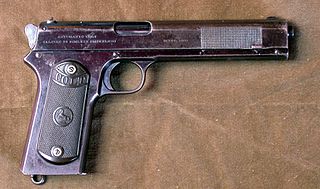
The Model 1902 is a semi-automatic pistol developed by famous American firearms designer John Browning and produced by the Colt's Patent Firearms Manufacturing Company in the early 20th century. The Model 1902 was not a new design, but rather an incremental improvement upon the nearly identical M1900, and would transition from the 1900 into three distinct but related pistols with the same action and cartridge, the 1902 Sporting Model, the 1902 Military model, and the 1903 Pocket Hammer model. The 1902 Sporting model was so similar to the 1900 that it continued the serial number range, while the 1902 Military Model featured a different serial range as did the 1903 Pocket Hammer model. The 1902 Military Model featured a square and lengthened grip frame with an additional round in the magazine, while the 1903 Pocket Hammer featured a shortened barrel and slide but retained the Sporting model grip frame. The Colt M1905 .45 ACP pistol would be derived from the same lineage, also with a different serial number range.

A handgun is a firearm designed to be usable with only one hand. It is distinguished from a long gun which needs to be held by both hands and braced against the shoulder. Handguns have shorter effective ranges compared to long guns, and are much harder to shoot accurately. While most early handguns are single-shot pistols, the two most common types of handguns used in modern times are revolvers and semi-automatic pistols, although other handguns such as derringers and machine pistols also see infrequent usage.
The Colt Model 1903 Pocket Hammer was a short-recoil, semi-automatic pistol, designed by the American arms designer John Browning. It was a compact version of the Colt Model 1902 Sporting Model pistol derived from the original Colt M1900. The Colt M1902 Sporting Model and 1903 Pocket Hammer models differ significantly from the military-inspired Colt 1902 Military Model although they fire the same cartridge. Its design is in no way related to the Colt Model 1903 Pocket Hammerless or the FN Model 1903 pistol.
The following are terms related to firearms and ammunition topics.
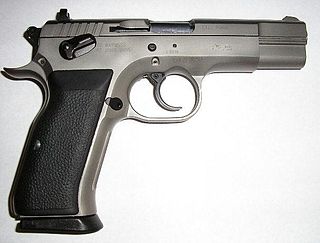
The Tanfoglio Combat or Standard, also known as T(A)95 or EAA Witness Steel, is a modified clone of the Czech CZ-75/CZ-85 pistol. It is made in Gardone Val Trompia near Brescia, Italy by Fratelli Tanfoglio S.N.C.

The Roth–Steyr M1907, or, more accurately Roth-Krnka M.7 was a semi-automatic pistol issued to the Austro-Hungarian kaiserliche und königliche Armee cavalry during World War I. It was the first adoption of a semi-automatic service pistol by the army of a major military power.

The FN FNX pistol is a series of semi-automatic, polymer-framed pistols manufactured in Columbia, South Carolina, by FN America, a division of Fabrique Nationale d'Herstal. The pistol is chambered for the 9×19mm Parabellum, .40 S&W, and .45 ACP cartridges. It was introduced in 2009 as the successor to the FN FNP.
